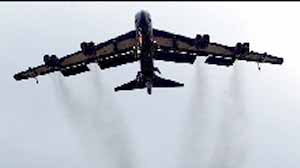
A U.S. Air Force B-52 bomber arrives at RAF Fairford in western England on Monday, March 3, 2003. The United States is basing more heavy bombers near North Korea and will formally protest the communist nation's ``reckless actions'' in using MiG fighters to intercept a U.S. surveillance plane, officials said Tuesday, March 4, 2003. Other Pentagon officials said the deployment includes sending B-52 bombers to the U.S. Pacific territory of Guam. (AP Photo/Dave Caulkin) |
WASHINGTON - The United
States is basing more heavy bombers near North Korea and will formally
protest the communist nation's "reckless actions" in using MiG fighters
to intercept a U.S. surveillance plane, officials said.
Shifting the military aircraft toward northeast Asia was described "as a prudent gesture to bolster our defense posture and as a deterrent" by Defense Department spokesman Lt. Cmdr. Jeff Davis on Tuesday. Other Pentagon officials said the deployment includes sending B-52 bombers to the U.S. Pacific territory of Guam. The order was issued Friday, well before Sunday's incident in which North Korean jets came within 50 feet of a U.S. RC-135S surveillance plane over the Sea of Japan, they said. "These (U.S.) moves are not aggressive in nature," Davis said. |